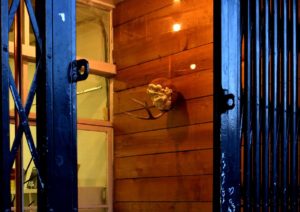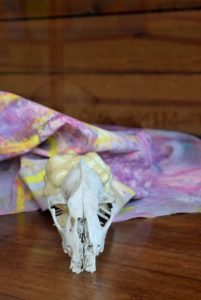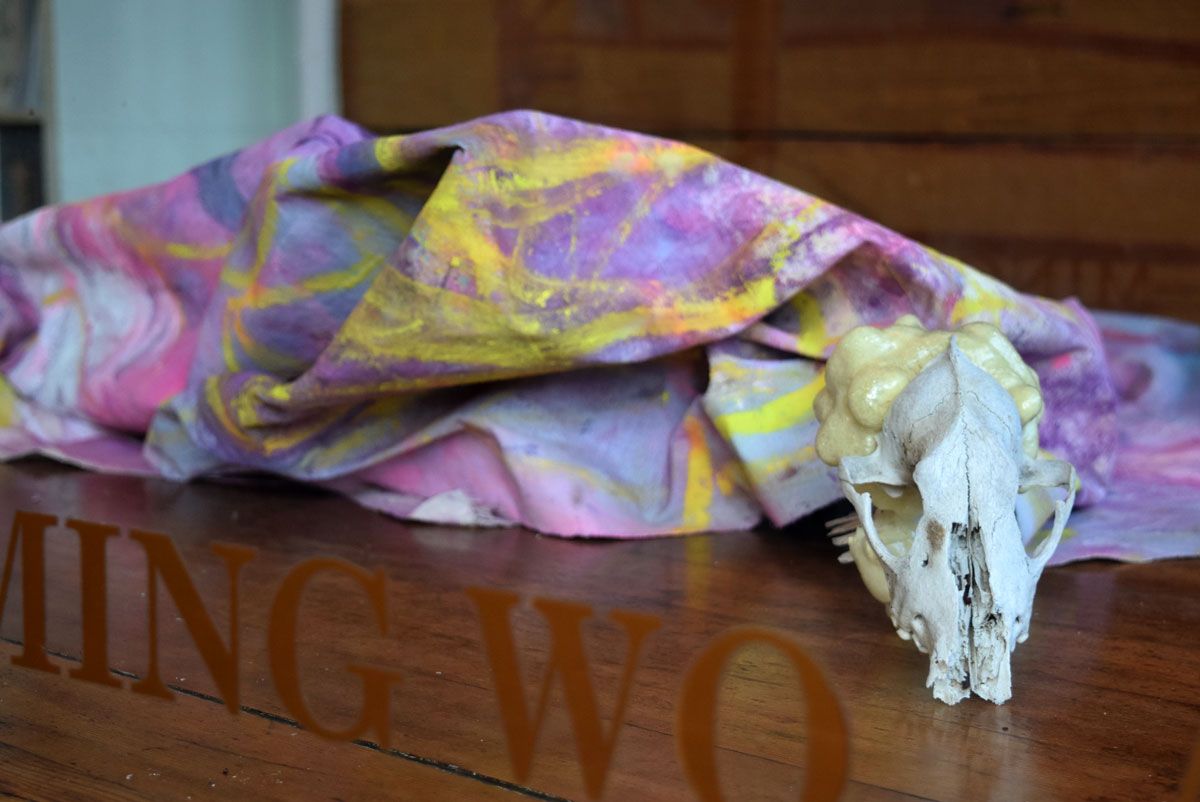A fox cranium, a spine carcass and a centerpiece of tethered canvas is sealed with insulation foam. You can see papaya yellows and purple orchid hues splattered, coated and painted through the window of the exhibit. On the wall hangs a deflated basketball and a pair of antlers.
We met outside of Massy Arts, on East Pender and Chinatown. Esteban Peréz was wearing a purple fleece zip-up, the shade of purple seen on a rippled sheet of canvas in his exhibition, “Unfinished Marks.” The exhibition came from a series of walking practices which Esteban initially used to get to know East Pender a little better, where he found familiarity in street vendors, smells and spills reminiscent of a vibrant, living community — like his home in Quito, Ecuador.
Milena: Is there a reason you used the colors you did?
Esteban: I always use pinks and purples — I’m wearing purple right now! This painting is a response to the visual environment here in Chinatown, but also there’s a direct relation to the Latin American urban landscape —when you go on buses or when you walk on the streets, you see a lot of these colors. So I think that’s a part of my subconscious, the colors have always been there, I don’t relate it to happiness necessarily, it’s more related to a vibrancy, or an energy beyond a specific feeling.
As we switch between Spanish and English, there’s this continual sense of flow and duality that rings in the background of our bi-lingual conversation. Or maybe it was just my ears, or my spanglish. Or the loud orchestra of crows, stop-lights and natural pauses taking place around, as we walked to Or Gallery.
A small cranium peaks under the cover. Insulated foam decorates the animal’s spine like congealed fat, making it feel like whatevers dead under that blanket is in fact, still alive.
E: Yeah — I like how it falls, and how that has created this sense of a body.. For me it felt like an extension of the skeleton, and I was imagining this other being living beyond reality, or beyond the human realm. I was thinking of the spirits of the forest, and spirits of nature, in relation to this painting — or even this medium — and how that canelate to the city. How those two temporalities collide or intersect.
As we were walking together, practicing the methodology Esteban also practiced in his work, we encountered fresh fruit markets, muraled alleys and stopped to listen to a man on a corner playing an accordion.
small splintered hands
yellow paint, light blue
la cuna de un illustration
Think: tethered canvas. Earth. Calle 13. Calles en violeta. Guscia. amarillo, a rotting banana peel. Heavy cloth. Pesado y frio, con ternura y tierra. Maqueta desinflada.
Espiritu de un zancudo, toma sangre del suelo. deja que te muerdan, con pasitos pequenos.
Recoje tus suenos. Cubierto en sal y miel. Terris nullus, spine colander. Sift through pinks, purpled tooths. Splatter collars. Break luz.
Man en mano.
X
Esteban used his phone to record sounds, take pictures and create an emotional cartography of East Pender, Chinatown. At first, he was just doing that for himself, trying to understand and get to know the place, the social codes, the fabric of the city and spaces around him. We pass by fruit stands, and he points out how there’s fruit stands everywhere in South America. Un estudio en junio. No air conditioning, it was hot. The canvas was too big — Esteban folded it for easier transportation. I asked him what felt so familiar about these two places on opposite poles, he said that it was the static.
M: How do these places feel familiar?
E: Even though I understand that it’s a different culture, and a different language — the static is kind of similar in that the atmosphere and the sensations that it provokes in me feel familiar. So it has more to do with sensations, definitely.
M: Say that we were making a bullet point list of like those types of aesthetics, what comes to mind?
E: Something that seems true in it’s chaos and complexity — it feels human. There’s good parts and bad parts.Especially in relation to the gentrification that we were talking about earlier, and how that somehow feels generic, or not ‘real’, I guess. It looks ‘shiny and new,’like it’s trying to be something for a specific purpose — whereas places like this (Sun Wah Centre) for example, it is just what it is. It’s not trying to sell you an identity, they know who and what they are.
Alejandro Aravena, a Chilean architect known for his work in socially-conscious housing, springs up in conversation. Specifically, his project ‘Elemental’, where he was commissioned by the government of Chile to create social housing, and had the idea to make housing which allowed families to finish the other half. One half had all the basic appliances, a heater, toilet, concrete floors, and the other was left for the family to decide how they wanted to build and personalize their home outside of the government’s reach. The houses became a living entity that kept growing, a purposefully unfinished project able to be molded to meet people’s specific needs.

M:Can you describe to me when you were in the valley and you were picking up the pieces of “Unfinished Marks?”
E: I had this residency in the Similkameen Valley, near Keremeos in the interior of British Columbia. The studio was in the middle of nature, and a different type of nature than the tropics I was used to in Ecuador. This nature was more relaxed — even though I was scared of bears.
But again this place was so raw, the wildlife was very present. I saw a coyote outside of the studio, and then I walked that way and found a couple of bones. As I was walking around the property I found the craniums and I collected them. I also found a banana box that was somehow from Ecuador. So, I assembled the banana box,put the bones inside, and some feathers I found from a peacock. It kind of looked like an altar or a shrine — like the ones you see in South America on the side of the road. Now that I think about it, it sounds kind of creepy. I guess I wanted to explore that, or to make a joke just for myself. It wasn’t intended for anyone — because that’s my art, just things that make me laugh.
Like the whole banana box, and just questioning this idea of exocitizing myself, and playing with my identity. Which a lot of artists do. Because when you see my work you don’t really relate [it] to Latin American aesthetics, o es algo que ves tan facil. When you see my work I’m not trying to portray an idea of Latin America, I’m using ideas and concepts from where I come from, but the final outcome is not charged with those symbols.
M: What are some of the similarities you see between your home in Quito, Ecuador & here?
E: I think a lot about sound, and riding the bus. I have a friend from El Salvador, who always plays Bachata. And I’m like ahh, because it reminds me of riding the bus in Quito at 6:00 am — so I relate Bachata to the bus. There are aesthetics here that feel familiar to me, because it’s chaotic, it feels like real people create that unintentional and emerging aesthetic Created by the flow of people, and the relationship between humans.
Pieces of identities can spill out while you’re walking, from your bag, your drink, your trash, your treasures. Unintentional memorials can be left on our way home, or our commute to work. The more you talk to people on your afternoon walk, the more you leave the memory of yourself in the minds that run, sell and speak your neighborhood into existence. Within improvised chaos, Esteban’s exhibition lives in places that aren’t made in secret, but yelled by vendors and found in the palms of waxed fruit baskets.
Their lifespan also doesn’t expire at a date, but maybe at an hour. An hour of permission, to take and give what you can, while you’re still here.
They also live in language, phonetically in dialects, for example in different Latin American accents, chilean, argentinian, peruvian and those different alike.
Unfinished marks can be found in spit, heat, splatters, dents, holes and accidents. They never die, and live again when we see them through pictures, fixing, mending and experiencing them the way we see fit. The emptiness, is a void for pleasure, and disgust. Bad, good. Where it goes, is neither here, nor there – it’s about being willing to leave it in the first place.
X

M: I know the topic of spirits is something common for a lot of people in Latin America, but what drew you to start thinking about spirits and temporalities in your work?
E: I met Splash, a Squamish artist, in North Vancouver for my last project, and he showed me his ID as an indigenous person. He also invited me to his home and I learned a lot of indigenoust history. Then we went to the forest, he sang a song, asking his ancestors’ permission to go to the forest. For me that wasn’t weird or foreign. Like yeah, you should ask for permission from nature, and to your ancestors. You should always be respectful and enter nature with a different mindset. It’s not, “I’m gonna conquer this,” but, I’m asking permission from the mountain to let me in, and for its protection, because it’s dangerous.That’s how I understood that other connection to nature, to land — from Splash. I wanted to treat the land with the same kind of respect.
luz se encuentra. luz, me habla. luz, me olvida, trajo paz, despues…
con orgullo, oro. plata. tierra.
planta plata en mis palmas, llama oro con tu voz. toma orgullo con tu cuello toma, carinos con los dos.
planta mis palabras como oro, tu caverna. una tierra caliente. que duerme pocas horas, que se despierta en la noche, pensando en tus… sonando de noche. extrañando el sol.


